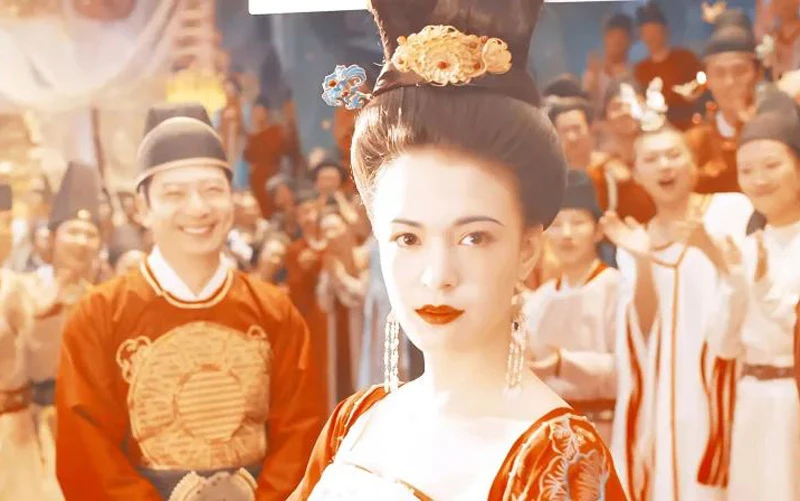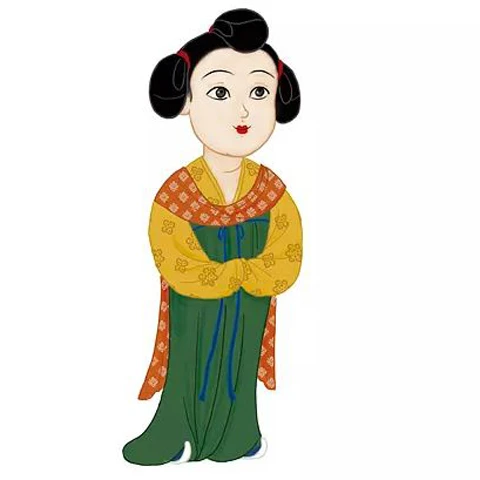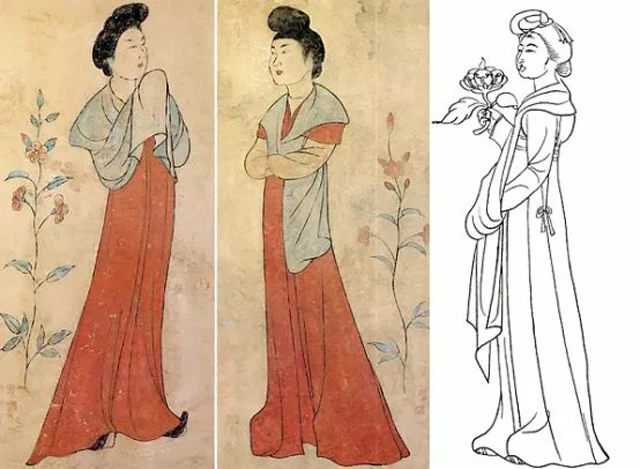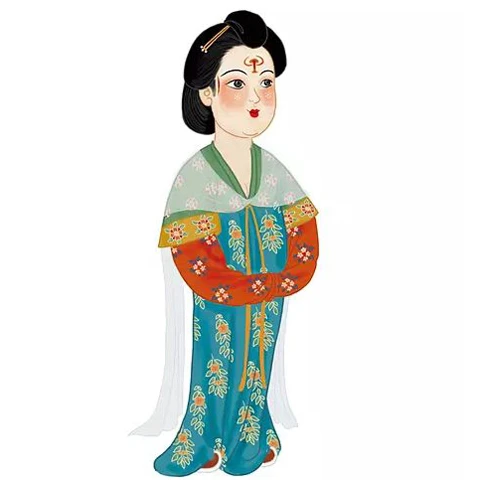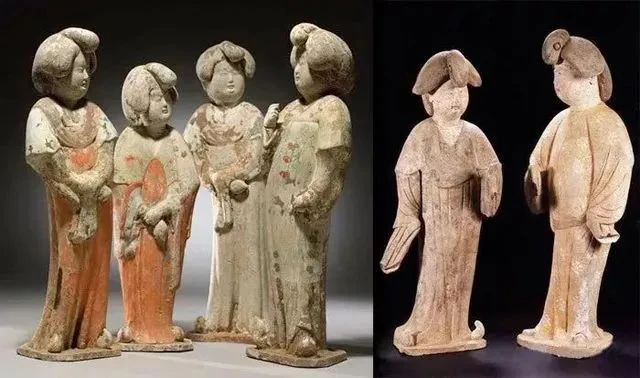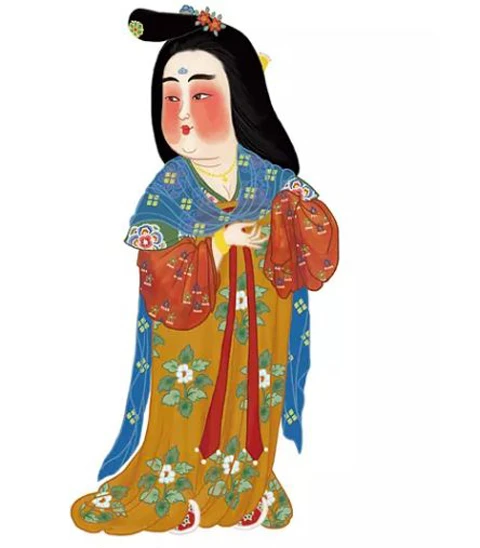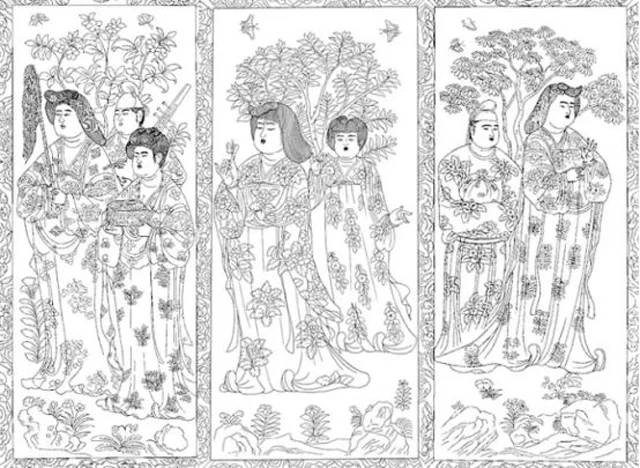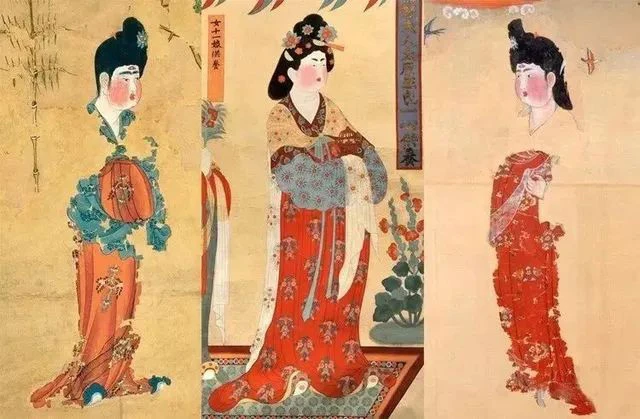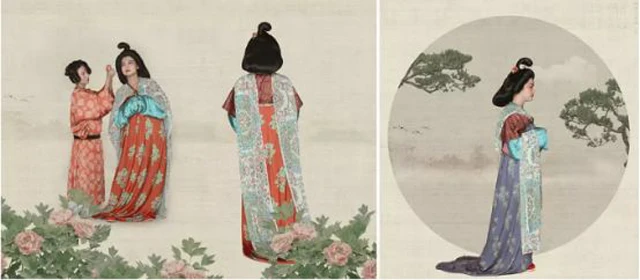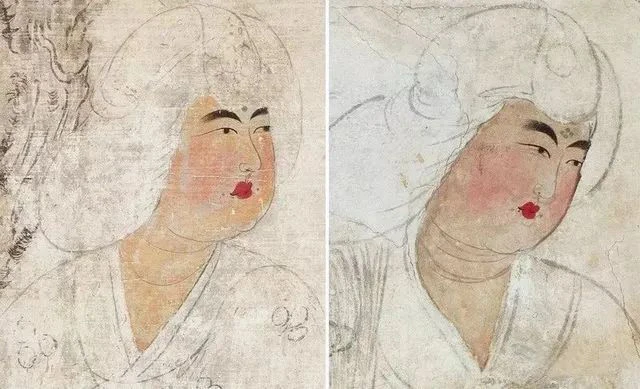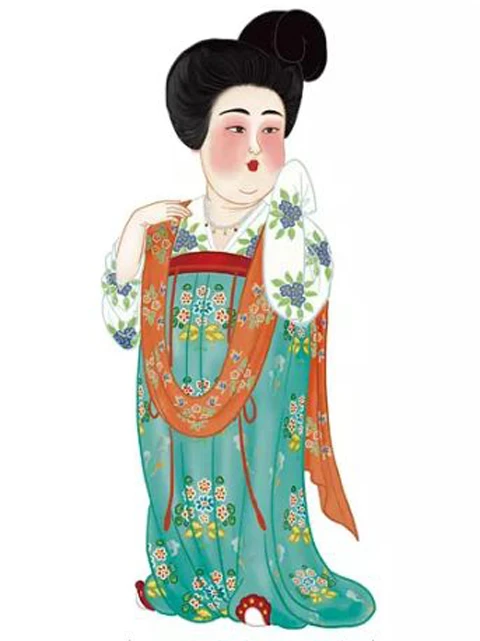The Tang Dynasty was known for its admiration of plumpness and loose clothing style, which emerged after the appearance of Yang Guifei. By examining these reliable historical materials, we can discover that the Kaiyuan and Tianbao periods were the fastest-changing phases in fashion during the Tang Dynasty. Therefore, we will use Yang Yuhuan's life as a reference to explore the history of women's fashion during the flourishing Tang Dynasty, focusing on four stages: her childhood in the early Kaiyuan period, her time in Luoyang during the middle of the Kaiyuan period, her status as a noble concubine in the early Tianbao period, and her tragic end in the late Tianbao period.
From the early Tang Dynasty to the Wu Zhou period, the trend of women's fashion can be summarized as follows: from the slender and conservative style at the beginning of the Tang Dynasty, to the gradually opening up under the reign of Emperor Dezong, and finally to the magnificent and flourishing Wu Zhou era. This was a time when the aesthetic ideals of Tang Dynasty women were characterized by elegance, confidence, and the willingness to showcase their figures. It was closely related to the influence of Empress Wu Zetian, as well as other influential women such as Shangguan Wan'er, Princess Taiping, and Consort Wei.
01 Early Kaiyuan Period: Simplicity and Moderation
After the Shenglong Revolution and the abdication of Empress Wu, the "Wu Zhou style" continued for more than ten to twenty years until the early years of Emperor Xuanzong's reign in the Kaiyuan period. In the first decade of the Kaiyuan period, the body shape remained similar to that of the Wu Zhou era, with an emphasis on an upright and full chest, and a preference for revealing the neckline.
The clothing style still consisted of short shirts, long skirts, and long scarves; the sleeves of the shirts were narrow, and the long skirts were relatively fitted. The makeup was simple and understated, with the hair neatly arranged, occasionally with a high bun, but more commonly with a small bun gathered at the top of the head.
Yang Yuhuan was born in the seventh year of the Kaiyuan period (719) and spent her early years in the Shu region. Therefore, during her childhood, Yang Yuhuan would have worn simple narrow-sleeved dresses and had the appearance of a young girl with twin braids or three small buns. Although the clothing and hairstyles were similar to those of the Wu Zhou era, the women in the palace during the early Kaiyuan period had simpler clothing decorations. This was closely related to Emperor Xuanzong's determination to govern diligently and frugally when he first ascended the throne.
In the early Kaiyuan period, Emperor Xuanzong believed that "excessive luxury and extravagance in clothing and accessories would harm social customs." After his ascension, he issued several edicts to strictly prohibit such practices. Under the governance of Emperor Xuanzong and his wise officials, the Tang Dynasty entered the glorious Kaiyuan era.
02 The Formation of the Flourishing "Kaiyuan Style"
In the seventeenth year of the Kaiyuan period (729), at the age of ten, Yang Yuhuan came to Luoyang to live with her uncle Yang Xuangui after her father's death. She stayed in Luoyang for five years. In July of the twenty-second year of Kaiyuan, Princess Xianyi held a wedding in Luoyang, and Yang Yuhuan was invited to attend. The younger brother of the princess, Prince Shou, fell in love with Yang Yuhuan at first sight. Under the request of Prince Shou's mother, Empress Wu Hui, Emperor Xuanzong issued a decree that same year to marry Yang Yuhuan as the princess's consort.
At this time, it was the second decade of Li Longji's reign, and the popular clothing styles and hairstyles in Chang'an and Luoyang had completely departed from the influence of the Wu Zhou era and the earlier emphasis on simplicity, gradually forming a new "Kaiyuan style."
The most distinctive feature was the hairstyle, with a prominent half-circle of fluffy sideburns, and a small bun on top of the head, which was lowered and hung down. This became the most popular hairstyle, spreading throughout the country, and even similar buns were found in Astana, Xinjiang. Sometimes, a headscarf was wrapped around the bun.
There were some subtle changes in body shape. Overall, it moved away from the slender and upright style of the previous hundred years of the Tang Dynasty and began to embrace a plumper figure. The shoulders and chest became more solid, often with stiffened half sleeves underneath the shirt, making the upper body appear broader. The waistline also moved up to the chest. The waist and abdomen slightly protruded, and due to the unique tailoring techniques, the lower part of the garment tightened, creating a top-heavy and bottom-light silhouette. This gradually became the mainstream figure shape that we commonly describe as "fish-shaped" or "spindle-shaped."
03 Entry into the palace as a concubine
In the 22nd year of the Kaiyuan era (734), Yang Yuhuan was bestowed the title of Princess Shou by imperial decree. In the fourth year of the Tianbao era (745), Emperor Xuanzong, after granting the daughter of Wei Zhaoxun the title of Princess Shou, elevated Yang Yuhuan from being a daughter-in-law to the esteemed position of Imperial Concubine. As no empress had been established at this time, Yang Guifei's status was equivalent to that of the empress.
From the later years of the Kaiyuan era to the Tianbao era, it seemed that women were embarking on a rapid path towards corpulence, sparking a collective enthusiasm for plumpness. This trend became even more pronounced during the Tianbao era. Archaeological evidence confirms that each passing year witnessed an increase in corpulence, where being plump was considered beautiful.
The figures were even more bloated than the spindle-shaped fish-tail silhouettes of the earlier Kaiyuan era. The fabrics used for clothing also reached unprecedented levels of extravagance. For the first time in Tang Dynasty women's fashion, garments and robes were adorned with intricate patterns.
In addition, depictions of court ladies found in numerous imperial and noble tombs in the two capital cities of this period all invariably portrayed them as voluptuous, languid, and dressed in loose and sumptuous attire. Their makeup was characterized by vivid and exaggerated red accents, with thick eyebrows and various goose-yellow Huadian ornaments adorning their foreheads, creating a striking visual impact. The preferred colors for the skirts were intense shades of red and orange, paired with contrasting blue-green tops. Delicate and exquisite gauze veils completed the ensemble.
This trend not only prevailed in the capital area, but also spread far and wide to other regions. For example, the famous Dunhuang Cave 130, dating from the Tianbao era, depicts the wife of a regional military commander paying homage to Buddha. Similarly, the silk paintings of court ladies found in the tomb of Zhang's family, an official of the Anxi Protectorate in Astana, Xinjiang, during the third year of the Tianbao era, align closely with the prevailing style in Chang'an.
04 The zenith of plump
In the later years of the Tianbao era, the noblewomen's figures continued to embrace an even more corpulent path, almost attaining a barrel-like shape with uniform width from top to bottom. During the Song Dynasty, women's figures transitioned towards a slender aesthetic, particularly during the Southern Song period. The portrayal of women in paintings from this era featured pencil-like figures. Naturally, when Song people viewed the Tang Dynasty beauties depicted in Zhou Fang's paintings, they perceived them as excessively "plump" and "corpulent."
Based on recent archaeological discoveries, the depictions in the "Court Ladies Adorning Their Hair with Flowers" painting should represent the image of noblewomen from the late Tang Dynasty and the Five Dynasties period, although later attributed to Zhou Fang by Qing Dynasty scholars. Despite the discrepancies in clothing and hairstyles that do not accurately reflect the historical reality, in the 1990s, television dramas still tended to opt for plump portrayals, aiming to capture the grandeur of the prosperous Tang Dynasty while balancing historical authenticity and contemporary aesthetics.
From the 1990s to the present, the various portrayals of Yang Guifei in film and television can be seen as rooted in the "Court Ladies Adorning Their Hair with Flowers" painting. Casting choices also leaned towards fuller and more opulent appearances in the 1990s, while the aesthetic preference shifted towards a slender face and body in the 21st century.
